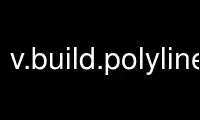
This is the command v.build.polylinesgrass that can be run in the OnWorks free hosting provider using one of our multiple free online workstations such as Ubuntu Online, Fedora Online, Windows online emulator or MAC OS online emulator
PROGRAM:
NAME
v.build.polylines - Builds polylines from lines or boundaries.
KEYWORDS
vector, topology, geometry, line, node, vertex
SYNOPSIS
v.build.polylines
v.build.polylines --help
v.build.polylines input=name output=name [cats=string] [type=string[,string,...]]
[--overwrite] [--help] [--verbose] [--quiet] [--ui]
Flags:
--overwrite
Allow output files to overwrite existing files
--help
Print usage summary
--verbose
Verbose module output
--quiet
Quiet module output
--ui
Force launching GUI dialog
Parameters:
input=name [required]
Name of input vector map
Or data source for direct OGR access
output=name [required]
Name for output vector map
cats=string
Category number mode
Options: no, first, multi
Default: no
no: Do not assign any category number to polyline
first: Assign category number of first line to polyline
multi: Assign multiple category numbers to polyline
type=string[,string,...]
Input feature type
Options: line, boundary
Default: line,boundary
DESCRIPTION
v.build.polylines builds polylines from the lines or boundaries in a vector map.
A line is defined by one start node, one end node and any number of vertices between the
start and end node. The shortest possible line consists of only two vertices where the
coordinates of the start and end node are identical to those of the two vertices.
v.build.polyline picks a line and from its start node, walks back as long as exactly one
other line of the same type is connected to this node. Line directions are reversed as
required, i.e. it does not matter if the next line is connected to the current node by its
start or end node. Once the start line of a polyline is identified, it walks forward and
adds all vertices (in reverse order if needed) of connected lines to the start line, i.e.
the start line and connecting lines are reversed as needed. That is, if a line is reversed
depends on what node is initially picked for building polylines. If the direction of lines
is important (it’s not for boundaries to build areas), you have to manually change line
directions with either v.edit or the wxGUI vector digitizer.
Polylines provide the most appropriate representation of curved lines when it is important
that nodes serve to define topology rather than geometry. Curved lines are usually
digitized as polylines, but these are sometimes broken into their constituent straight
line segments during conversion from one data format to another. v.build.polylines can be
used to rebuild such broken polylines.
NOTES
v.build.polylines combines only lines of the same type to a new polyline, i.e. lines and
boundaries are kept separate.
Category number(s) are assigned to a polyline based on cats parameter.
· cats=no - No category number is assigned to a polyline. Also attributes tables
linked to the input vector map are not copied to the output vector map.
· cats=first - Assign to a polyline category number of the first line. All linked
attributes tables are copied to the output vector map without filtering, but the
categories are processed according to the cats option.
· cats=multi - If the lines that make up a polyline have different category numbers
then v.build.polylines will set the multiple category numbers to a polyline. Also
all linked attributes tables are copied to the output vector map.
v.build.polylines correctly handles input vector maps containing lines, boundaries,
centroids and points. Lines and boundaries will be converted to polylines. Areas are
guaranteed to be preserved.
ACKNOWLEDGEMENTS
This program was originally written during Mark Lake’s tenure of a Leverhulme Special
Research Fellowship at University College London.
Use v.build.polylinesgrass online using onworks.net services
